Key Themes of This Report
10% of Americans own a smartphone but do not have broadband at home, and 15% own a smartphone but say that they have a limited number of options for going online other than their cell phone. Those with relatively low income and educational attainment levels, younger adults, and non-whites are especially likely to be “smartphone-dependent.”
Smartphones are widely used for navigating numerous important life activities, from researching a health condition to accessing educational resources. Lower-income and “smartphone-dependent” users are especially likely to turn to their phones for navigating job and employment resources.
A majority of smartphone owners use their phone to follow along with breaking news, and to share and be informed about happenings in their local community.
Smartphones help users navigate the world around them, from turn-by-turn driving directions to assistance with public transit. This is especially true for younger users.
An “experience sampling” of smartphone owners over the course of a week illustrates how young adults have deeply embedded mobile devices into the daily contours of their lives.
The experience sampling survey illustrates that smartphone usage often produces feelings of productivity and happiness, but that many users also feel distracted or frustrated after mobile screen encounters.
The traditional notion of “going online” often evokes images of a desktop or laptop computer with a full complement of features, such as a large screen, mouse, keyboard, wires, and a dedicated high-speed connection. But for many Americans, the reality of the online experience is substantially different. Today nearly two-thirds of Americans own a smartphone, and 19% of Americans rely to some degree on a smartphone for accessing online services and information and for staying connected to the world around them — either because they lack broadband at home, or because they have few options for online access other than their cell phone.
Indeed, 7% of Americans own a smartphone but have neither traditional broadband service at home, nor easily available alternatives for going online other than their cell phone. This report documents the unique circumstances of this “smartphone-dependent” population, and also explores the ways in which smartphone owners use their phones to engage in a wide range of activities.
Below are some more details about these major findings on the state of smartphone ownership in America today, based on a series of surveys conducted by Pew Research Center in association with the John S. and James L. Knight Foundation:
Nearly two-thirds of Americans are now smartphone owners, and for many these devices are a key entry point to the online world
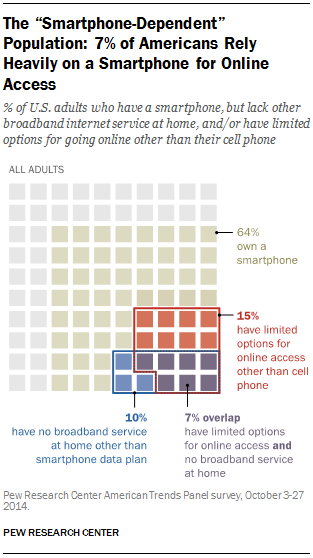
And for a number of Americans, smartphones serve as an essential connection to the broader world of online information. The survey measured reliance on smartphones for online access in two different ways — first, by asking smartphone owners whether or not they have traditional broadband service at home, and second, whether they have a reasonable number of options for accessing the internet in general from any location. It found that:
- 10% of [tweetable url="http://pewrsr.ch/1NF3kbK" alt="10% of Americans have no broadband service at home other than their smartphone data plan."]Americans own a smartphone but do not have any other form of high-speed internet access at home beyond their phone’s data plan.
- Using a broader measure of the access options available to them, 15% of Americans own a smartphone but say that they have a limited number of ways to get online other than their cell phone.
Certain groups of Americans rely on smartphones for online access at elevated levels, in particular:
- Younger adults — 15% of Americans ages 18-29 are heavily dependent on a smartphone for online access.
- Those with low household incomes and levels of educational attainment — Some 13% of Americans with an annual household income of less than $30,000 per year are smartphone-dependent. Just 1% of Americans from households earning more than $75,000 per year rely on their smartphones to a similar degree for online access.
- Non-whites — 12% of African Americans and 13% of Latinos are smartphone-dependent, compared with 4% of whites.
Compared with smartphone owners who are less reliant on their mobile devices, these smartphone-dependent users are less likely to own some other type of computing device, less likely to have a bank account, less likely to be covered by health insurance, and more likely to rent or to live with a friend or family member rather than own their own home.
The connections to online resources that smartphones facilitate are often most tenuous for those users who rely on those connections the most
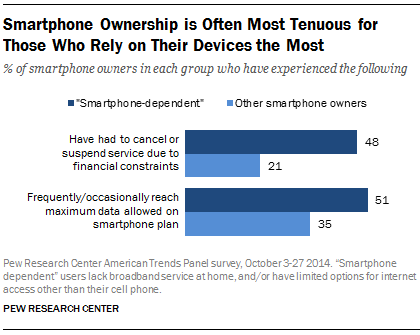
Even as a substantial minority of Americans indicate that their phone plays a central role in their ability to access digital services and online content, for many users this access is often intermittent due to a combination of financial stresses and technical constraints.
[tweetable url="http://pewrsr.ch/1NF3kbK" alt="48% of smartphone-dependent Americans have had to cancel or shut off their cell phone service for a period of time."]Smartphone owners of all kinds use their phone to help navigate numerous important life events; lower income and “smartphone-dependent” users are especially likely to use their phone for job and employment resources
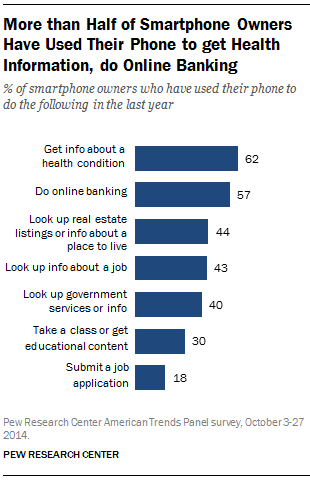
Smartphones are used for much more than calling, texting, or basic internet browsing. Users are turning to these mobile devices as they navigate a wide range of life events:
- 62% of smartphone owners have used their phone in the past year to look up information about a health condition.
- 57% have used their phone to do online banking.
- 44% have used their phone to look up real estate listings or other information about a place to live.
- 43% [tweetable url="http://pewrsr.ch/1NF3kbK" alt="43% of smartphone owners have used their phone in the past year to look up information about a job."]to look up information about a job.
- 40% to look up government services or information.
- 30% to take a class or get educational content.
- 18% to submit a job application.
Lower-income smartphone owners are especially likely to use their phone during a job search. Compared with smartphone owners from households earning $75,000 or more per year, those from households earning less than $30,000 annually are nearly twice as likely to use a smartphone to look for information about a job — and more than four times as likely to use their phone to actually submit a job application.
Similarly, “smartphone-dependent” users are much more likely to use their smartphones to access career opportunities. 63% of these smartphone-dependent users have gotten job information on their phone in the last year, and 39% have used their phone to submit a job application.
Young adults (85% of whom are smartphone owners) are also incorporating their mobile devices into a host of information seeking and transactional behaviors. About three-quarters of 18-29 year old smartphone owners have used their phone in the last year to get information about a health condition; about seven-in-ten have used their phone to do online banking or to look up information about job; 44% have consumed educational content on their phone; and 34% have used their phone to apply for a job.
A majority of smartphone owners use their phone to follow along with breaking news, and to share and be informed about happenings in their local community; smartphones also help users navigate the world around them, from turn by turn driving directions to assistance with public transit
A substantial majority of smartphone owners use their phone to follow along with news events near and far, and to share details of local happenings with others:
- 68% of smartphone owners use their phone at least occasionally to follow along with breaking news events, with 33% saying that they do this “frequently.”
- 67% use their phone to share pictures, videos, or commentary about events happening in their community, with 35% doing so frequently.
- 56% use their phone at least occasionally to learn about community events or activities, with 18% doing this “frequently.”
Each of these behaviors is common across a diverse group of smartphone owners. Mobile news consumption is common even among older smartphone owners, who tend to use these devices for more basic activities. Four-in-ten smartphone owners ages 65 and older use their phone at least occasionally to keep up with breaking news, half use it to share information about local happenings, and one-third use it to stay abreast of events and activities in their community.
Smartphones also play an important role in helping their owners navigate their environment and get where they need to go, especially as a mobile GPS for real-time driving directions:
- 67% of smartphone owners use their phone at least occasionally for turn-by-turn navigation while driving, with 31% saying that they do this “frequently.”
- 25% use their phone at least occasionally to get public transit information, with 10% doing this “frequently.”
- 11% use their phone at least occasionally to reserve a taxi or car service. Just 4% do so frequently, and 72% of smartphone owners never use their phone for this purpose.
Each of these behaviors is especially prevalent among younger smartphone owners: for instance, 17% of smartphone owners ages 18-29 use their phone to reserve a taxi or car service at least occasionally. Additionally, African American and Latino smartphone owners look up public transit information on their phones at higher rates than whites (37% of black smartphone owners, 30% of Latinos, and 21% of whites do this at least on occasion).
Users view smartphones as freeing, connecting, helpful, and usually worth the cost — but not always essential
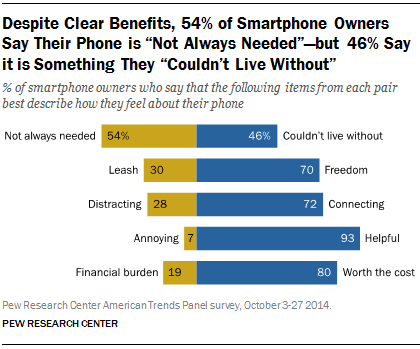
When asked to choose from a series of statements representing how they feel about their phone, a substantial majority of smartphone owners feel that these devices are “helpful” rather than “annoying,” “connecting” rather than “distracting,” and that they represent “freedom” rather than a “leash.”
A special “experience sampling” survey of smartphone owners offers new insights into how Americans use their mobile devices
In addition to the surveys of smartphone owners that form the main findings of this report, the Pew Research Center also conducted an “experience sampling” survey of smartphone owners as part of this project. In the experience sampling survey, smartphone owners were contacted twice a day over a period of one week and asked how they had used their phone in the hour prior to taking the survey. This analysis offers new insights into how smartphone owners interact with their mobile devices on a day-to-day basis: the features and apps they use; the locations where that use happens; the issues or problems they use their phones to solve; and the emotions they feel as a result.
Text messaging is the most widely-used smartphone feature but voice/video calling remains popular, even among young smartphone owners; email continues to retain a place of prominence in the smartphone era
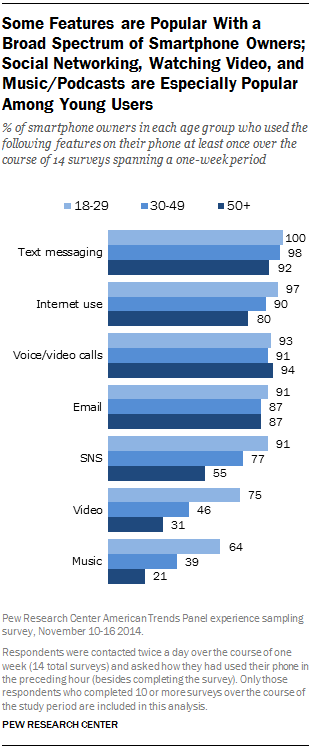
Fully 97% of smartphone owners used text messaging at least once over the course of the study period, making it the most widely-used basic feature or app; it is also the feature that is used most frequently, as the smartphone owners in this study reported having used text messaging in the past hour in an average of seven surveys (out of a maximum total of 14 across the one-week study period). Younger smartphone owners are especially avid users of text messaging, but this group has by no means abandoned voice calls — 93% of smartphone owners ages 18-29 used voice or video calling on at least one occasion during the study period, and reported doing so in an average of 3.9 surveys.
Email has long ranked as one of the most common activities that users take part in online since the desktop/laptop era, and it continues to play a prominent role in the mobile era as well. Some 88% of smartphone owners used email on their phone at least once over the course of the study period, making email a more widely-used smartphone feature than social networking, watching video, or using maps and navigation, among others.
Social networking, video consumption, and music/podcasts are especially popular with younger smartphone owners
Three smartphone features in particular — social networking, watching video, and listening to music or podcasts — are especially popular with younger users. Fully 91% of smartphone owners ages 18-29 used social networking on their phone at least once over the course of the study period, compared with 55% of those 50 and older (a 36-point difference). These young smartphone owners reported using social networking in an average of 5.6 surveys, tied with internet use as the second-most frequent smartphone behavior among young adults after text messaging.
Features such as watching video and listening to music or podcasts are even more the domain of young smartphone owners. Three-quarters of younger smartphone owners (75%) indicated using their phone to watch videos at least once over the study period, compared with 31% of those 50 and older (a difference of 44 percentage points). And 64% of younger adults used their phones at one time or another to listen to music or podcasts — a 43-point difference compared with the 21% of older users who did so.
Young users are particularly likely to use a smartphone to avoid boredom — and ignore other people
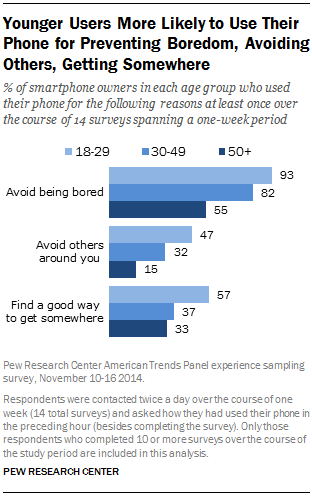
Younger users stand out especially prominently when it comes to using their phone for two purposes in particular: avoiding boredom, and avoiding people around them. Fully 93% of 18-29 year old smartphone owners in the experience sampling study used their phone at least once to avoid being bored, with respondents in this age group reporting that they did so in average of 5.4 surveys over the one-week study period. Similarly, 47% of young smartphone owners used their phone to avoid interacting with the people around them at least once during the study period, roughly three times the proportion of older smartphone owners who did so.
Smartphones frequently inspire their owners to feel “productive” and “happy” — but can also lead to distraction and frustration
When it comes to the emotions that people experience as a result of having a smartphone, “productive” and “happy” lead the way — 79% and 77% of smartphone owners, respectively, indicated that their phone made them feel this way at least once over the course of the study period. But smartphones do not always inspire positive feelings, as 57% of smartphone owners reported feeling “distracted” thanks to their phone, and 36% reported that their phone made them feel “frustrated.”
Younger smartphone owners tend to experience a wider range of these emotions compared with older users — they are more likely to report feeling positive emotions like “happy” or “grateful,” but also more likely to report negative emotions like “distracted” and “angry.”
More details about the data sources used in this report
This report is based on data from three different sources, each of which is discussed in more detail below.
Basic findings on smartphone ownership and demographics within the U.S. adult population (the first section of Chapter One) are based on telephone surveys conducted December 4-7 and 18-21, 2014 among 2,002 adults. These figures for overall smartphone ownership/usage were collected via telephone survey to make them consistent with past Pew Research Center measurements of smartphone adoption. The margin of error for the total sample of 2,002 adults is plus or minus 2.5 percentage points. For more details about this survey, see Appendix A.
Findings about how smartphone owners use their phones (the remainder of Chapter One, and Chapter Two) are drawn from the October wave of the American Trends Panel, conducted October 3-27, 2014 among 3,181 respondents (2,875 by Web and 306 by mail), including 2,188 smartphone owners. The margin of sampling error for the total sample of 2,188 smartphone owners is plus or minus 2.7 percentage points. For more details about this survey, see Appendix B.
Data about how smartphone owners use their phones over the course of one week (Chapter 3) is taken from the American Trends Panel “experience sampling” survey, conducted November 10-16, 2014 among 1,635 respondents. Respondents were asked to complete two surveys per day for seven days (14 in total), using either an app they had installed on their phone (n=697) or by completing a web survey (n=938). All findings in this report are based on respondents who completed 10 or more surveys over the course of the week-long study period (n=1,035). The margin of sampling error for smartphone owners who completed 10 or more surveys is plus or minus 4.0 percentage points. For more details about this survey, see Appendix C.




